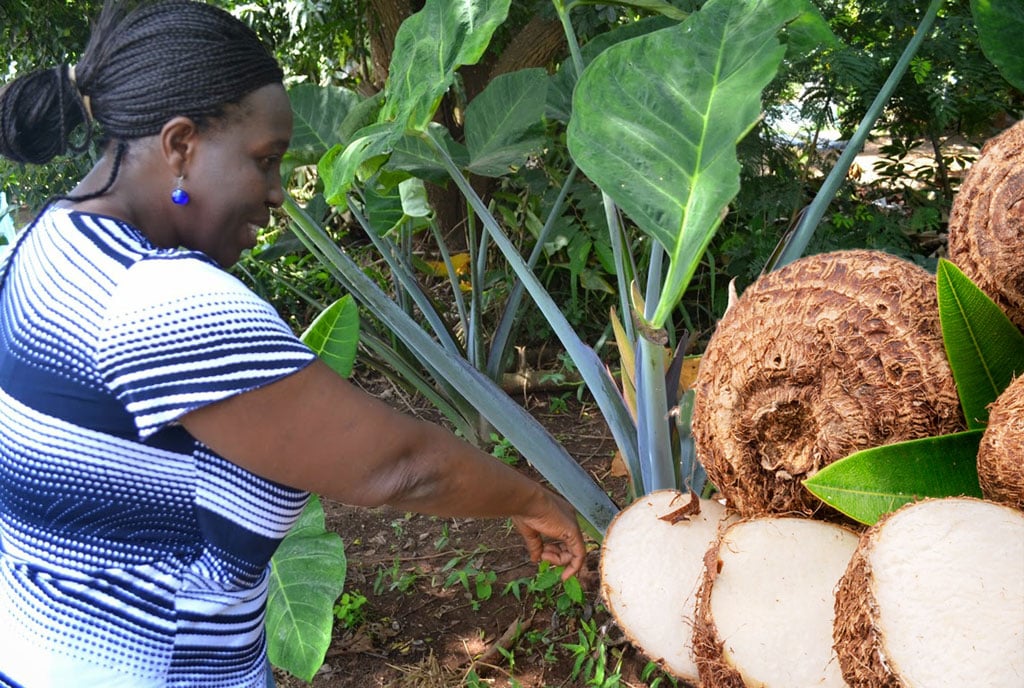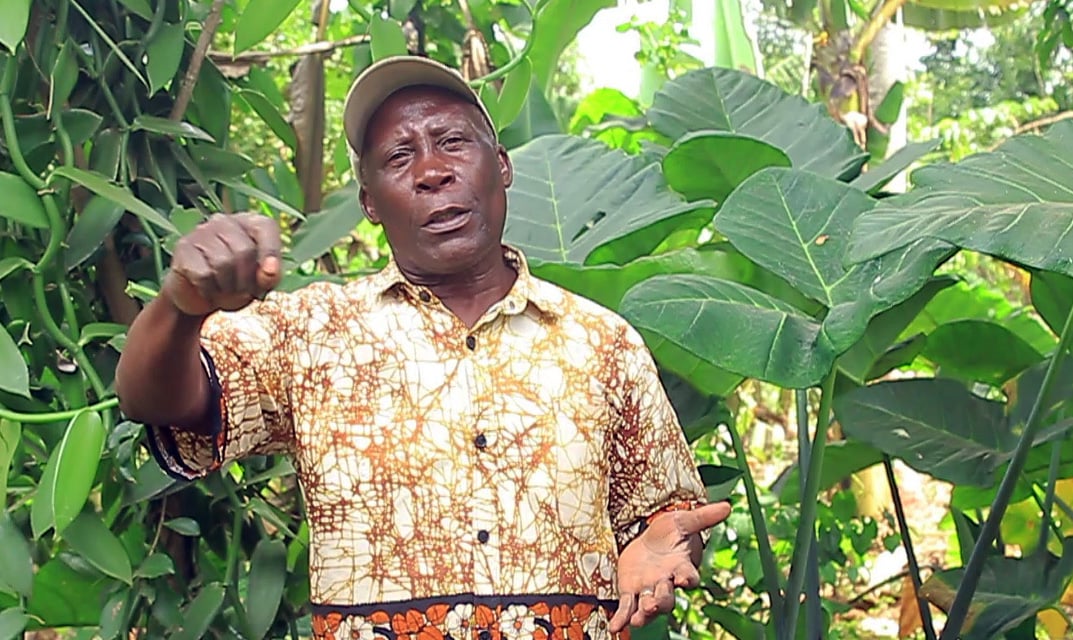
A farmer explains how to weed a cocoyam garden. PHOTO/COURTESY
Farmers in Uganda have knowledge in growing of root tuber crops such as cassava, sweet potatoes, Irish potatoes and yams but not coco yams.
Coco yams are known to be grown on small scale naturally in swampy areas and it is of recent that farmers are taking it up due to its nutritional benefits.
Background
Cocoyam is an important tropical tuber crop grown purposely for its starchy corms. It is widely cultivated in Oceania, Africa and Asia.
It is categorised as a neglected food crop and is mainly grown for subsistence agriculture.
It is regarded as one of the most important staple crops in the Pacific Islands, India and Indonesia and considered as primary centres of origin of the taro variety.
It is sad to originate from Indo-Malaysian region of India and Bangladesh from where it spread into the Pacific islands, the eastern Mediterranean and Africa.
Another variety referred to as tannia is believed to have originated in the tropical valleys of north-eastern South America.
Tannia was introduced into West Africa from where it spread to other parts of the continent including Uganda.
Varieties and production groups
In a recent publication in the Australian Journal of Crop Science by Jane Muthoni and Hussein Shimelis scientists from Kenya Agricultural and Livestock Research Organization (KALRO ), they highlight facts about minor root and tuber crops in Africa; the case of ocoyams as below.
There are more than 200 varieties of cocoyams worldwide that were selected for their edible corms or cormels and ornamental purposes.
Cocoyams fall into two main production groups which include wetland and upland cocoyams.
Wetland cocoyams grow in paddy fields where water is abundant, while the upland types are cultivated in places where water is supplied by rainfall or supplemental irrigation.
Despite the high production, food value and economic opportunities of cocoyams, they are often traded in local markets.
Therefore the scientists came up with the research paper to highlight the value of cocoyam as a minor tuber crop and the extent and challenges of its production in Africa.
Utilisation of cocoyams and nutrition benefits
Cocoyams are mainly used as food although some plant parts are also used as fodder, feed and medicine. People consume its leaves and inflorescence. The leaves are rich in minerals such as calcium, phosphorus, iron and vitamins including C, thiamin, riboflavin and niacin.
In most African countries, the tubers are generally baked or boiled and eaten as a snack alongside beverages while the leaves are steamed as vegetables.
In the eastern Democratic Republic of Congo and most parts of West Nile region, cocoyam has become a major food crop. Where the tubers are boiled and consumed with various types of sauce.
Global cocoyam production
The scientists explain that global production of cocoyam has not changed much in recent times.
Taro is more popular with tannia contributing a small proportion of the global production. Globally, taro ranks 5th among root and tubers and 17th among staple crops.
Tannia accounted for less than 5 percent of the global cocoyams output from 2011 to 2020.
Cocoyam production in East Africa
In East Africa, cocoyam cultivation is generally restricted to wetlands. There is widespread, small-scale cocoyam production within the wetlands of Lake Victoria basin in Kenya, Uganda and Tanzania.
Awareness on the nutritional benefits of cocoyams has been growing recently; this is elevating the commercial value of the crop.
This has seen cocoyams enter into lucrative markets resulting in better incomes for smallholder farmer.
The agronomy
Cocoyam is one of the tuber crop used as food in Uganda. The tuber is more pronounced in the Buganda region and is locally known as Obukupa.
The crop is mainly grown among small scale farmers whose farm operations are mainly subsistence.
In Uganda farmers mainly grow two varieties which they refer to as the white and the pink cocoyams.
Soil requirements
Cocoyam thrives better on well drained sandy loam soils. However the crop produces optimally when planted in fertile soils with good water retention capacity.
Propagation and planting
Cocoyam propagation is vegetative where farmers could use a whole corm or the cormel can be cut in to sets for planting. Open up holes 3 to 5 inches below the surface and set in corm pieces. Cover with soil and then gently firm with soil and maintain a spacing of 4 by 4 feet and 1 by 1 spacing apart.
Watch out for nematodes as they will limit cocoyam growth and for this reason the crop is normally grown on virgin soils.
Like other crops maintain a clean field by weeding to prevent foliar pests and other disease causing organisms.
Harvesting and marketing
Most cocoyam varieties mature in about 8 months from planting. Harvesting can however start from six months. This is done by shaking up the plant and uprooting it to bring out the cormel.
Cocoyams are mostly marketed as fresh tubers in local markets like Nakasero, Owino, Kalerwe for urban consumers. They are sometimes found on road side stalls and in village markets.
Varieties
There are more than 200 varieties of cocoyams worldwide that were selected for their edible corms or cormels and ornamental purposes.

